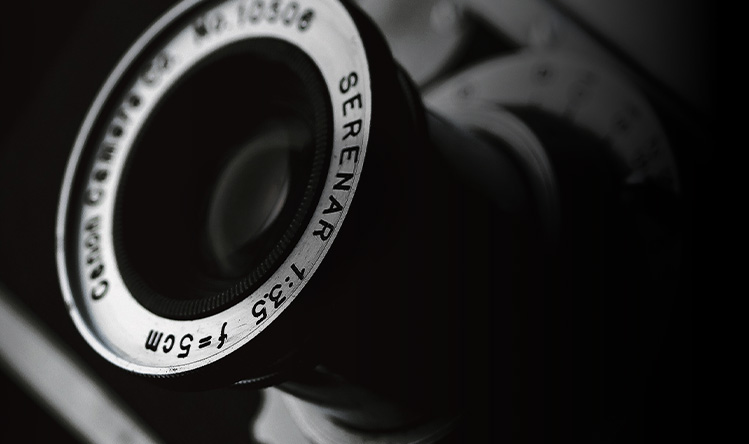The Never Ending Challenge
– The History of Canon Lenses
Canon has a long history of lens-making, and its products have evolved from early rangefinders to the R Series of lenses, the FL Series, the FD Series, the EF Series, and now the RF Series. At every step of this evolution, Canon has focused on developing features that expand the range of photographic possibilities. Aspherical lenses, fluorite, USM, IS, and DO lenses, and other new technologies have been developed and introduced, helping Canon maintain its position as world leader in lens development. The examples below include some of the Canon lenses that have made a mark in the history of lens development.
-
- 1946
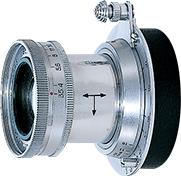
-
Canon’s first camera lens
Serenar 50mm f/3.5 ICanon first began working to produce lenses in the late 1940s. The first lens it released to the public was the Serenar 50mm f/3.5, which was developed and manufactured completely in-house. The name “Serenar,” which means “clear,” was intended to reflect the clarity that the development team was aiming for.
- 1946
-
- 1951
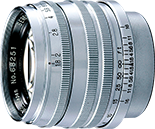
-
A lens recognized for world-class quality
Serenar 50mm f/1.8 IFive years after it started manufacturing lenses, Canon introduced what would become widely known as a classic lens. Building on the basic structure of a Gauss-type lens (one of the main lens types) and developing it further, Canon achieved crystal-clear imaging performance even at full aperture. Lens designers worldwide were impressed with the result, and Canon lenses quickly gained a reputation for world-class quality.
- 1951
-
- 1953
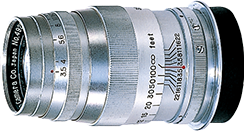
-
Lightweight and compact design
Serenar 100mm f/3.5 ICanon’s first 100mm lens was the long-focus type f/4 Triotar, which was constructed with three lens elements in three groups. The first real commercial success, though, came with Canon’s launch of the telephoto-type 100mm f/3.5, a lightweight, compact medium-telephoto lens with five lens elements in four groups. The first such lens was just 69.5mm long, with a maximum diameter of 44mm, and weighed just 205g (7.2 oz). The model II was even lighter, at 184g (6.5 oz.), and quickly became a hit among camera buffs.
- 1953
-
- 1961
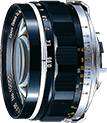
-
The world’s largest camera lens aperture
Canon 50mm f/0.95
- 1961
-
- 1964
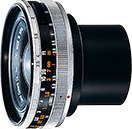
-
The world’s widest angle of view for a camera lens
FL19mm f/3.5When first released, this super wide-angle 19mm lens boasted the widest viewing angle of any SLR camera lens. The symmetrical arrangement of the optical system — with concave lens elements in the front and back and convex lens elements in the center — helped eliminate distortion, comatic aberration (also known as astigmatism) and chromatic magnification error. The concave lenses provide good peripheral illumination despite the super-wide angle. Previous lenses that adopted this type of optical system found it difficult to correct spherical aberration and deliver sufficient brightness at the periphery, while minimizing size. The FL19mm f/3.5 successfully overcame these problems thanks to the use of a convex lens group. The lens was sold with a special viewfinder, since the mirror had to be retracted in order to attach the lens to the camera body. This lens was commonly used to take portrait photos with a slightly surreal effect.
- 1964
-
- 1969
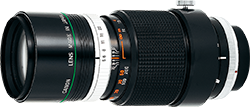
-
World’s first* camera lens to use fluorite
FL-F300mm f/5.6Canon was one of the first manufacturers to research ways to use fluorite — which has characteristics that optical glass cannot match — as a material for camera lenses. Unfortunately, natural fluorite rarely forms large crystals, and it often contains impurities that make it unsuitable for use in a camera lens. Canon successfully developed techniques to eliminate the impurities and grow fluorite crystals artificially. The first Canon lens to use fluorite was the FL-F300mm f/5.6. Not only did the use of fluorite help to eliminate colour aberration, but it also made it possible to design shorter lenses. This 300mm lens was among the most compact and innovative super-telephoto lenses of its day. Since then, fluorite lens elements have been introduced in many other EF lenses as well as many of the lenses in the high-performance, super-telephoto L Lens Series.
* An interchangeable lens for cameras sold to general consumers
- 1969
-
- 1971
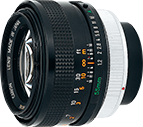
-
The first large-aperture aspherical SLR lens with automatic diaphragm control
FD55mm f/1.2 AL1971 saw the release of the F-1, Canon’s first SLR camera with professional specifications. The FD Series of lenses, released in conjunction with the F-1, received high marks for optical performance including high contrast, sharpness and outstanding colour balance as well as excellent mechanical performance and easy operation. The FD55mm f/1.2 AL was the first aspherical lens for an SLR with auto-diaphragm control. Light rays entering the edge of a spherical lens are refracted differently than those passing through the center. When using a large-aperture lens, this may cause the focal point for these rays of light to become misaligned, causing spherical aberration and increasing the chances of lens flare. Aspherical lenses solve this problem, suppressing lens flare at full aperture while still delivering high contrast images. Canon had to engineer its own machine tools to make these lenses — one more example of how our comprehensive approach to development helps turn new technological advances into unique new products.
- 1971
-
- 1973
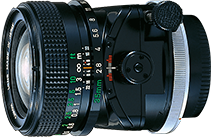
-
World’s first* tilt-shift lens for 35mm cameras
TS35mm f/2.8 SSCThis was the first 35mm camera lens to offer tilt and shift functionality, making it ideal for the sort of architectural and commercial photography that had formerly been dominated by large-format view cameras. This lens served as the springboard for launching Canon’s EF Series TS-E lenses.
* Refers to 35mm cameras
- 1973
-
- 1973
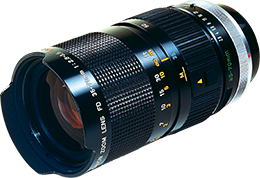
-
A ground-breaking short zoom lens
FD35-70mm f/2.8-3.5 SSCThe simple yet unique two-lens-group design of this lens broke new ground for short zoom lenses. It was equipped with a precise zoom barrel construction which moved the front and rear lens groups at the same time in a non-linear fashion — the front and rear lens groups moving further apart at wide angles and converging in the telephoto range — without changing the length of the barrel. The diaphragm was designed to move in concert with the rear lens group, while the aperture diameter changed in accordance with zoom adjustments. This truly innovative lens even came with a macro setting. At the time, zoom lenses were rarely used by professional photographers because their optical performance was significantly inferior to that of single-focal-length lenses. However, as the exceptional performance of this lens gained recognition, it became a standard piece of equipment for professionals.
- 1973
-
- 1975
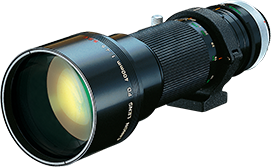
-
The first Canon lens to adopt a rear-focus design
FD400mm f/4.5 SSCIn the 1970s, most conventional telephoto lenses had a very bulky mechanical structure because focusing was achieved by adjusting the length of the entire barrel. The FD400mm f/4.5 SSC, however, introduced a rear-focus design where the focus could be adjusted by moving only one part of the lens, making operation much smoother. It also featured a variable focus pitch system, which focuses on the subject slowly for distant shots and swiftly for close-ups, just like the human eye. This compact and lightweight rear-focus design has since been employed in many lenses, and greatly facilitated the development of the high-speed autofocus system used in Canon EF lenses.
- 1975
-
- 1982
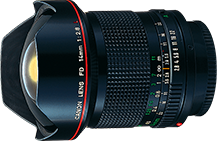
-
Leading-edge Canon software used to develop a super-wide-angle lens
New FD14mm f/2.8LThis was the widest-angle lens in the FD lens series, employing aspherical lens elements to eliminate distortion. Canon had to develop its own computer software to design the aspherical lens — a good example of how our emphasis on perfecting basic and peripheral technologies allows Canon to make cutting-edge technological advances.
- 1982
-
- 1989
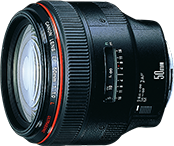
-
World’s largest* aperture AF SLR lens (*as of 1989)
EF50mm f/1.0L USMWhen launched, this standard lens boasted the largest aperture of any 35mm SLR camera lens. With two ground and polished aspherical elements and four high-index refractive glass lens elements, it delivers outstanding imaging performance with high contrast and minimal flare, even at the maximum aperture of f/1.0. The floating mechanism helps maintain high picture quality even at close focusing distances, while the electronic manual focus function allows full-time manual focusing with a very light touch even in autofocus mode. This enhances the already rapid autofocus, which is driven by a ring-type Ultrasonic Motor (USM).
- 1989
-
- 1993
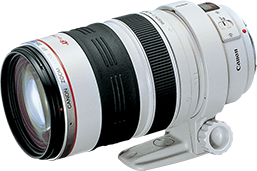
-
The first* interchangeable zoom lens for SLR cameras with a 10x magnification ratio
EF35-350mm f/3.5-5.6L USMThis was the first zoom lens for SLR cameras to offer a maximum zoom ratio of 10x. This lens delivered reliable performance at any range from wide-angle to super-telephoto, even in situations that required high mobility, such as sports photography. Its design featured six lens groups, five of which are movable, to successfully combine a high zoom ratio with compact size. Two UD lenses were used to correct colour aberration, thus producing high-resolution images and outstanding contrast. The lens was also renowned for features such as a smoothly rotating tripod collar, a special ring to adjust zooming friction, full-time manual focus, and other convenient features.
* For SLR cameras with interchangeable lenses
- 1993
-
- 1995
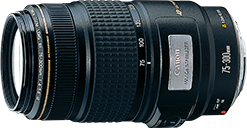
-
The first*1 image stabilizer for an interchangeable 35mm camera lens
EF75-300mm f/4-5.6 IS USMThis was the first interchangeable telephoto lens for SLRs equipped with an image stabilization (IS) function. This innovative lens featured a pair of gyro sensors to detect camera movement and move the second lens grouping in the opposite direction, thus cancelling out any movement that could possibly blur the image. The IS effect of this mechanism was equivalent to a two-stop increase in shutter speed.*2 A micro USM was used to drive the autofocus, thus reducing motor noise.
*1 For 35mm SLR cameras with interchangeable lenses
*2 The shutter speed limit for hand-held photography (without image stabilization) can be calculated in seconds as [1/focal length of the lens].
- 1995
-
- 1997
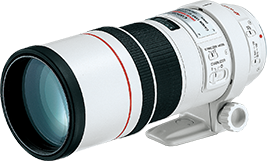
-
The first L-series lens with image stabilization mechanism
EF300mm f/4L IS USMThis telephoto lens was the first Canon professional lens to be equipped with an image stabilization (IS) mechanism, which made it possible to take handheld shots in situations that formerly required the use of a tripod. The IS mechanism has a stabilizing effect equivalent to a roughly two-stop increase in shutter speed.* The lens featured two modes: mode 1 is effective for shooting stationary subjects, and mode 2 is suitable for panning shots. Two Ultra-low Dispersion (UD) lenses in the optical system minimize chromatic aberration and produce high clarity and contrast throughout the entire image. By demonstrating that an image stabilization mechanism is useful even for skilled professional photographers, this lens convinced a growing number of professional photographers to adopt Canon lenses with IS mechanisms.
* The shutter speed limit for hand-held photography (without image stabilization) can be calculated in seconds as [1/focal length of the lens].
- 1997
-
- 2001
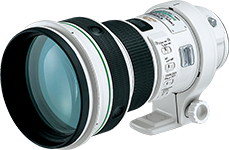
-
World’s first*1 camera lens to incorporate Canon DO (multi-layered diffractive optical) lens elements
EF400mm f/4 DO IS USMThe EF400mm f/4 DO IS USM was a super telephoto lens which for the first time included Canon’s own “DO lens” technology as part of the optical system. “DO lenses” use multi-layered diffractive optical (DO) elements to reduce size while maintaining high image quality. Compared to lenses with the same design specifications but only refractive optical elements, DO lenses reduce length by 27% and weight by 31%. This lens is equipped with an image stabilization (IS) mechanism that corrects blurring during hand-held photography to the same degree as a two-stop increase in shutter speed*2. It also features dust- and moisture-resistant construction and an AF stop function, giving it almost the same performance as the super-telephoto L-type IS lens series.
*1 Refers to interchangeable lenses for 35mm SLR cameras
*2 The shutter speed limit for hand-held photography (without image stabilization) can be calculated in seconds as [1/focal length of the lens].
- 2001
-
- 2008
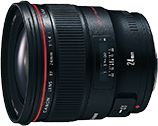
-
World’s first* camera lens with Subwavelength Structure Coating (SWC)
EF24mm f/1.4L II USMThis large-diameter 24mm wide-angle lens was the first* to feature revolutionary Subwavelength Structure Coating (SWC), an anti-reflection technology. SWC creates nanometer-scale irregularities on the surface of the lens — smaller than the wavelength of visible light — to effectively minimize lens flare and ghosting caused by light hitting the lens at a sharp angle. Conventional vapor-deposition coatings are often unable to address this problem, but SWC is a novel technology that uses microscopic irregularities on the lens surface to suppress reflection. The EF24mm f/1.4L II USM also features two high-precision, glass-molded aspherical lens elements and two UD lens elements to effectively eliminate various types of aberration. The floating mechanism provides high-resolution, high-contrast image quality throughout the image, even in the corners. SWC is a key technology that can expand the freedom of optical design and support further advances in Canon lens development.
- 2008
-
- 2009
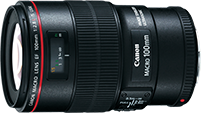
-
World’s first* interchangeable SLR lens to employ Hybrid IS
EF100mm f/2.8L
Macro IS USMThis mid-telephoto macro lens featured Canon’s Hybrid Image Stabilization (IS) system — the world’s first* optical image stabilizer capable of compensating for both angular and shift-type camera shake. Angular IS compensation is useful in most shooting situations, whereas shift shake compensation is useful primarily when taking close-up photos. In addition to the vibration gyro (angular velocity sensor) found in previous optical IS systems, Hybrid IS introduces an acceleration sensor to detect camera movement parallel to the focal plane. A new algorithm calculates camera shake based on readings taken by the two sensors simultaneously, and adjusts lens elements to compensate for both angular and shift-type camera shake. This two-pronged approach to minimizing camera shake greatly enhances handheld shooting capabilities in the macro range. The EF100mm f/2.8L Macro IS USM features a UD lens element to correct chromatic aberration. The end result is superb image quality, excellent durability and the easy operability that photographers expect from L-series lenses.
* Refers to interchangeable lenses for SLR cameras
- 2009
-
- 2010
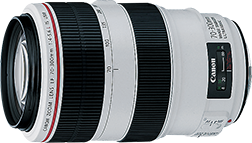
-
The first EF lens with a fluorine coating
EF70-300mm f/4-5.6L IS USMThis telephoto zoom lens was the first EF lens with a fluorine coating, which helps repel dust or smudges that affect image quality and reduces lens cleaning frequency. The coating creates a flat, smooth surface that repels liquid (including oil), prevents dust from adhering to the lens and makes cleaning much easier — often smudges can be removed with just a blower brush. Even hard-to-remove grime and fingerprints can usually be wiped clean with a soft dry cloth — no need for special cleaning solvents. This fluorine coating allows photographers to enjoy clearer photos and spend less time on camera maintenance.
- 2010
-
- 2011
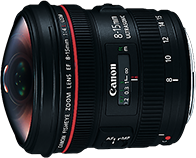
-
The world’s first* fisheye zoom lens for shooting both circular and rectangular, full-frame fisheye photos
EF8-15mm f/4L
Fisheye USMThis was the world’s first fisheye zoom lens that could cover a 180° angle of view, either horizontally or vertically. Circular fisheye pictures with a 180° angle of view in all directions can be shot with 35mm full-frame D-SLR cameras at a focal length of 8mm. This effectively records every object in front of the lens. Moreover, the lens can capture fisheye images with a 180° diagonal angle of view regardless of the image sensor size. When using cameras that have sensor sizes other than 35mm, an index mark on the side of the zoom ring will indicate the setting required to achieve a fisheye image with a 180° diagonal angle of view. This lens also featured a zoom limiter. Close focusing was possible as near as 0.15m (6 in.). allowing photographers to take advantage of the distorted perspective to give macro photos a unique impact.
* Refers to interchangeable lenses for SLR cameras
- 2011
-
- 2012
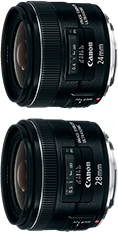
-
The first* wide-angle single-focal-length lenses with built-in image stabilization mechanism
EF24mm f/2.8 IS USM
EF28mm f/2.8 IS USMThe slowest shutter speed at which people can take handheld photos that do not suffer from the effects of camera shake is widely considered to be (1/focal length) second. Under the same shooting conditions, however, camera shake becomes less likely to occur as the lens’ angle of view increases. Improvements to the EOS DIGITAL technology’s image resolution have made it possible to check images on computer screens at original image resolution, but have also made subtle camera shake a noticeable problem, which would not have been an issue with film photos. Addressing this challenge, Canon made the world’s first* wide-angle single-focal-length lenses with a built-in image stabilization (IS) mechanism. This expanded the lens’ expressive range by making handheld shooting at slow shutter speeds a viable option.
* Refers to interchangeable lenses for SLR cameras
- 2012
-
- 2012
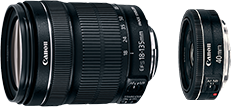
-
The world’s first* lenses with a stepping motor to drive an AF
EF-S18-135mm f/3.5-5.6 IS STM
EF40mm f/2.8 STMThese are the first interchangeable SLR lenses to use a stepping motor (STM) to drive the autofocus system, to deliver smooth and silent AF operation even when shooting movies or taking photos in Live View mode. The EF-S18-135mm f/3.5-5.6 IS STM offers remarkably silent operation and high-performance tracking during Movie Servo AF, thanks to a lead-screw-type AF drive. The EF 40mm f/2.8 STM features a gear-type AF drive system more suitable for a compact lens. In this case the pancake-type lens is just 22.8mm thick, and easy to use. By developing new actuators for the focus mechanism, Canon has been able to develop an even wider variety of EF lenses. Canon lenses fully accommodate the growing functionality of the EOS DIGITAL series, while offering photographers an ever-broader range of expression.
* Refers to interchangeable lenses for SLR cameras
- 2012
-
- 2013
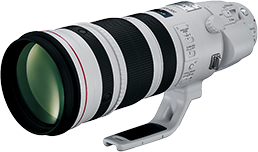
-
The world’s first* ultra-telephoto zoom lens with built-in extender
EF200-400mm f/4L IS USM Extender 1.4xThis epoch-making ultra-telephoto zoom lens features a built-in 1.4x extender, allowing the user to change its focal range from 200-400mm to 280-560mm with one quick, simple operation. This opens up new shooting possibilities — for example, it allows a photographer to switch on the fly from 400mm to 560mm focal length while looking through the viewfinder and taking photos. The unique optical design incorporates a fluorite lens and four Ultra-low Dispersion (UD) lenses to capture images that are as crisp and clear as those taken with single-focal-length ultra-telephoto lenses. The same features extend across the entire zoom range, even when the extender is used. The lens is constructed with 33 elements in 24 groups — among the most elements of any lens in the EF lens series — yet it is surprisingly compact, smoothly operable and very durable, thanks to the use of cutting-edge mechanical design, high-grade materials and production technologies. When used in conjunction with an attached EF1.4x III extender (and the built-in extender), the maximum focal length can be increased to 780mm. This allows for a maximum aperture of f/8, making it possible to use AF with cameras such as the EOS-1D X. Attaching an EF 2x III extender instead of an EF 1.4x III extender effectively transforms the lens into an ultra-telephoto zoom lens with a maximum focal length of 1,120mm. With all of these capabilities, this high-performance zoom lens paves the way for new telephoto shooting possibilities.
* Refers to interchangeable lenses for SLR cameras
- 2013
-
- 2014
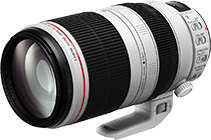
-
First lens to use ASC to reduce lens flare and ghosting
EF100-400mm
f/4.5-5.6L IS II USMThis lens was the first to feature Air Sphere Coating (ASC), a vapor-deposition-type coating which creates a layer made of silicon dioxide and air, with an ultra-low refractive index. This coating has excellent anti-reflective properties. It is particularly effective at blocking incident light that enters the lens at an angle almost perpendicular to the lens. This greatly reduces the incidence of lens flare and ghosting. Fluorite and Super Ultra-low Dispersion (UD) lens elements give the lens exceptional rendering power. The image stabilization (IS) is as effective at reducing camera-shake blur as a roughly four-step increase in shutter speed, to support hand-held telephoto shooting. This versatile, high-performance lens offers a variety of features that expand the range of possible expression, including a minimum focusing distance of 0.98m and a zoom adjustment feature that allows the user to make minute adjustments to the composition.
- 2014
-
- 2015
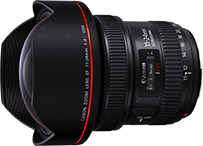
-
Revolutionary ultra-wide-angle zoom lens with minimum focal length of 11mm
EF11-24mm f/4L USMThis full-frame ultra-wide-angle zoom lens had a minimum focal length of 11mm. The lens array incorporates four aspherical lenses, including the world’s largest-diameter ground aspherical lens (87mm). Proprietary Canon technology was used to minimize the distortion that commonly occurs with wide-angle lenses, thus maintaining the high imaging performance users expect from the “L” series of lenses. In addition to a ground aspherical lens, UD and Super UD lenses are included to correct chromatic aberration, while the use of anti-reflective Subwavelength Structure Coating (SWC) and Air Sphere Coating (ASC), helps to reduce ghosting and lens flare.
* Refers to components of interchangeable SLR and mirrorless camera lenses, not including fisheye lenses.
- 2015
-
- 2015

-
Introduction of BR lens
EF35mm f/1.4L II USMThis was the first lens to incorporate Canon’s proprietary Blue Spectrum Refractive Optics (BR) lens, developed for ideal correction of chromatic aberration. BR optics correct the chromatic aberration that typically occurs in large-aperture lenses by leveraging unique anomalous dispersion characteristics that refract blue (shorter) wavelengths of light more acutely. In addition to the BR lens element, polished aspherical and UD lenses ensure exceptional rendering performance from the center of the image to the periphery, even when shooting at maximum aperture. The wide f/1.4 aperture makes it possible to take hand-held shots in low light, or to produce attractive out-of-focus effects, while ensuring that the viewfinder image is always bright and clear.
- 2015
-
- 2018
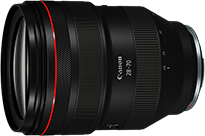
-
The world's first* large-aperture standard zoom lens with a maximum aperture of f/2 at all zoom ranges.
RF28-70mm F2 L USMThe RF28-70mm F2 L USM is the first lens to offer a maximum f/2 aperture across the entire range of focal distances from 28mm to 70mm. The lens takes advantage of the RF mount’s large diameter and short back focus to adopt an optical design that can deliver outstanding imaging performance and ease of handling. Effective arrangement of four aspherical elements and a super UD element gives the lens high resolution and high contrast from the center of the image to the periphery. Though it is a zoom lens, its imaging performance approaches that of single-focal-length lenses. It is suitable for portraits, landscape photography, and — thanks to its bright maximum f/2 aperture — even wedding photos and astrophotography. The RF28-70mm F2 L USM is a zoom lens that can take the place of multiple single-focal-length lenses. It is another step in Canon’s effort to leverage the unique capabilities of the RF mount, giving photographers an even broader range of expression.
* Refers to interchangeable autofocus standard zoom lenses for 35mm full-frame digital cameras.
- 2018
-
- 2018

-
First use of heat shield coating
EF400mm f/2.8L IS III USM
EF600mm f/4L IS III USMCanon’s first large-aperture super-telephoto lenses to adopt a heat shield coating. Both set new standards for light weight. The EF400mm f/2.8L IS III USM and EF600mm f/4L IS III USM weighed approximately 2,840g and 3,050g, respectively. Both lenses offer high image quality with greatly reduced weight. These lenses adopted a new basic design structure that consolidates all lens elements behind the initial (front-most) lens, incorporating fluorite and super UD elements, and new glass materials. An electronic focus ring and new image stabilization unit also reduce the weight of the mechanical design. The lens also includes a proprietary heat shield coating that reduces temperature increases in the lenses. The lens barrel design restrains thermal conduction, while a new white coating suppresses temperature rise in the lens barrel by enhancing reflectivity of infrared rays in sunlight. Together, these features enhance reliability during extended shooting in the hot sun.
- 2018
-
- 2019
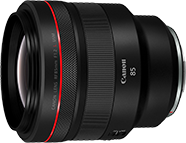
-
Development of DS coating, vapor-deposition technology
RF85mm F1.2 L USM DSImprovements to the optical functionality of a lens generally produce greater sharpness in previously blurry areas of a photo. However, some photographers want their photos to have a softer “bokeh” (blurred image) effect, even when the subject in focus has a higher resolution. To address these users, Canon has developed a proprietary vapor-deposition technology, known as Defocus Smoothing (DS) coating, which helps lenses to produce a better bokeh effect. This coating was first used on the RF85mm F1.2 L USM DS lens. The DS coating ensures that outlines of the image maintain a soft-focus, bokeh effect, while the in-focus subject retains high resolution, high contrast, and suppression of chromatic aberration. The RF85mm F1.2 L USM DS lens uses the ideal principles of Canon’s optical technology to open up a new dimension in bokeh expression.
- 2019
-
- 2021
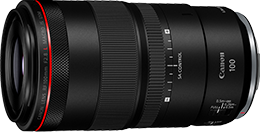
-
Macro photography with world’s first* maximum magnification of 1.4x
RF100mm F2.8 L
MACRO IS USMThe RF100mm F2.8 L MACRO IS USM is the successor to the EF100mm f/2.8L Macro IS USM, introduced in 2009, which featured the world’s first Hybrid IS. The new lens employs innovative new technology to achieve an unprecedented maximum macro lens magnification of 1.4x, with a minimum focal distance of 0.26m. This surpasses the maximum magnification of ordinary macro lenses, which is typically around 1.0x (actual size). Moreover, the RF100mm F2.8 L MACRO IS USM is the first Canon lens to employ a Spherical Aberration (SA) Control Ring. This new Canon technology, which can adjust the spherical aberration properties, expands the boundaries of macro photography.
* Refers to interchangeable AF lenses for full-frame mirrorless cameras. As of April 13, 2021. According to Canon surveys.
- 2021
-
- 2021
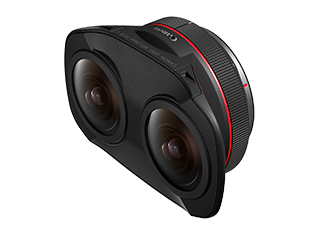
-
RF5.2mm F2.8 L
DUAL FISHEYE
— The world’s first*1 fisheye lens for 180° VR shooting in 3D, with an interchangeable-lens cameraIn the past, 3D VR images were shot using two separate fisheye cameras. This required a high degree of photographic expertise, not to mention the technology needed to turn the two shots into a 3D image. The EOS VR SYSTEM was developed to streamline the 3D VR image production process, and allow a wider range of photographers to create realistic and immersive 3D image content. Sales of the RF5.2mm F2.8 L DUAL FISHEYE began in 2021, making it the first interchangeable-lens product in the EOS VR SYSTEM, consisting of an interchangeable lens for shooting 3D VR images, a compatible EOS R series camera*2 and dedicated application software.
When this lens is attached to a compatible camera, it is possible to capture 3D 180° VR images making use of the parallax between the two fisheye lenses on the left and right sides. This system eliminates the need to adjust the positions of two separate cameras, and synchronize the settings prior to shooting, as was true with conventional two-camera systems. This improves the efficiency of video production significantly. The lens can be attached to the EOS R5/R5C/R5 Mark II to shoot high-definition images equivalent to up to 8K*3, allowing users to create highly immersive and realistic 3D VR images.*1 Based on Canon research, as of the date of release (October 5, 2021)
*2 Please check the product page for compatible cameras.
*3 The camera records video with a resolution equivalent to 8K with a fisheye image.
- 2021
-
- 2022
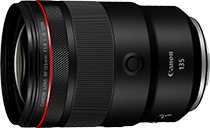
-
First 135mm (single-focal-length) medium telephoto lens with image stabilization mechanism
RF135mm F1.8 L IS USMThis mid-telephoto portrait lens is equipped with an in-lens image stabilization (IS) mechanism — the first ever in a 135mm single-focal-length lens*1. Combined with the coordinated control with the camera’s in-body IS, the IS improves image stability by the equivalent of up to 8.0 stops*2 in shutter speed. The maximum aperture value of F1.8 exceeds that of the EF135mm f/2L USM. Not only does this allow for a richer bokeh effect; the combination of a powerful camera-shake blur correction feature and a wide maximum aperture setting also ensure reliable performance when shooting in darker venues. This new lens offers breathtaking expressiveness and new potential for everyone who enjoys portrait photography.
*1 As of November 2022.
*2 When EOS R3 is used, based on CIPA standards (yaw/pitch directions only).
- 2022
-
- 2023
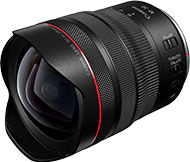
-
World’s first* ultra-wide-angle zoom lens with minimum focal length of 10mm
RF10-20mm F4 L IS STMThe RF10-20mm F4 L IS USM is the world’s first*1 ultra-wide-angle 10mm zoom lens, surpassing even the wide-angle range of the EF11-24mm f/4L USM. Despite its focal length of 10mm, the aspherical lens and Ultra-low Dispersion (UD) lens deliver image quality equivalent or superior to that of the EF11-24mm f/4L USM lens. The RF10-20mm F4 L IS STM delivers clear images with minimal colour bleed from the center to the periphery of the picture. In addition to its ultra-wide-angle capabilities, this lens is equipped with an image stabilizer.
Even with an extended wide-angle range and an image stabilization mechanism, the lens weighs just half as much as the EF11-24mm f/4L USM (lens alone). This is because it is the first L-series lens model to incorporate a Stepping Motor (STM), which has a smaller actuator than an Ultrasonic Motor (USM). The smaller actuator provides much greater freedom in designing the layout of the IS lens group, and makes it possible to place the IS mechanism on the sensor side of the lens. Furthermore, the RF10-20mm F4 L IS STM is the first Canon lens that is fully compatible with Peripheral Coordinated Control*2 *3 — a function that corrects the peripheral blur peculiar to wide-angle lenses.*1 As of October 10, 2023, for AF-compatible interchangeable zoom lenses (excluding fisheye lenses) for 35mm format SLR-type cameras. According to Canon research.
*2 Available on compatible cameras (EOS R5 with ver. 1.9.0 or later, as of October 10, 2023) when the movie digital IS is turned off.
*3 Movie digital IS is recommended when shooting video clips, particularly if there is a lot of panning or camera shake.
- 2023
-
- 2023
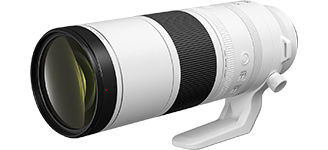
-
World’s first* super-telephoto zoom lens with top telephoto length of 800mm
RF200-800mm F6.3-9 IS USMThe world’s first* super-telephoto zoom lens with a maximum telephoto length of 800mm. It is useful when shooting subjects such as airplanes, trains, wild birds, and sporting events from telephoto range. With a low-end length of 200mm, users can enjoy a broad scope for zooming in, without having to change lenses. It is possible to take a series of pictures while zooming in when the subject is moving away or approaching from a distance. This lens is also compatible with the EXTENDER RF1.4x/RF2x, to further extend the telephoto range. Autofocus shooting with 1.4x or 2x focal length extenders is also supported.
* Refers to interchangeable AF lenses for mirrorless cameras compatible with full-frame sensors, which were released as of November 1, 2023 (according to Canon surveys).
- 2023
-
- 2023
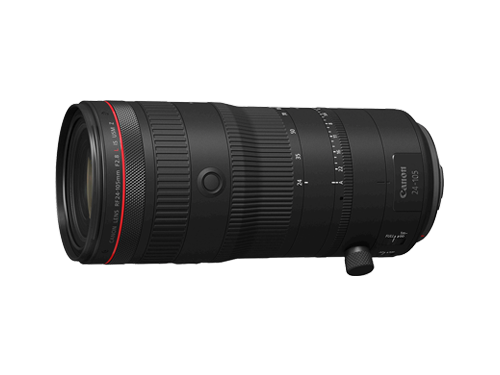
-
World’s first* 24-105mm zoom lens with fixed aperture f/2.8
RF24-105mm F2.8 L IS USM ZThe 24-105mm F4 series — a single lens which covers the range from wide-angle to mid-telephoto focal length — has long been one of the most popular categories of lens. Prior to the launch of this lens, the maximum aperture in the 24-105mm category was f/4, but the RF24-105mm F2.8 L IS USM Z is the first* to offer a fixed maximum aperture of f/2.8. This allows for f/2.8 shooting even at the telephoto (105mm) end, making it ideal for portrait photography that takes advantage of the vivid bokeh effect. It also achieves high image quality to match that of the RF24-70mm F2.8 L IS USM, making it suitable for professional use. The lens is compatible with the PZ-E2/E2B Power Zoom Adapter (sold separately), which supports more advanced video clip shooting. The PZ-E2/E2B enables high-precision, smooth zooming operation. This is an ideal zoom lens for use in nearly any type of video production.
* Refers to AF interchangeable lenses for mirrorless cameras compatible with full-frame sensors that have been released as of November 1, 2023 (based on Canon surveys).
- 2023


